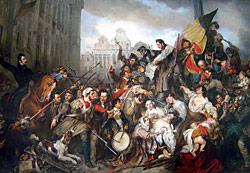
Unit 5: Crisis and Change
Lesson A: Competition Leads to Global Conflict
Activity 4: Long-Term Cause - Nationalism
Nationalism was a powerful idea that helped unify people in the 19th and early 20th centuries. The increased awareness of common traditions, ethnic backgrounds, customs, and languages became a strong force for unity in the late 1700s. Religion also continued to be a binding force between people. Nationalism inspired heightened unity in Germany and Italy during the 1800s and up into World War I. During the same time period, however, nationalism also started to become a source of conflict.
England, France, and other European countries were constantly competing – through war, land purchases, and negotiations and alliances. They also competed for economic advantage and increased territory in order to secure resources and raw materials to support their industrial growth. Ultimately, nationalism inspired the mistrust and dislike among European countries that fueled the tensions that resulted in World War I.
Nationalism allowed countries to justify imperialist actions and conflicts with other countries. In hotbed regions like the Balkans and in the multinational Austro-Hungarian and Russian Empires, many populations of people with common traditions, ethnic backgrounds, customs, or languages wanted the right to establish their own rule separate from the empires dominating them.
In Great Britain, France, Russia, and many other European countries, nationalist propaganda was used both as a tool to recruit additional military personnel after the outbreak of World War I and to justify the fighting. Think about how a strong sense of nationalism might contribute to causing and prolonging national conflicts and wars.
![]() Directions: Read each factor affecting nationalism and then determine if it is a source of unity or conflict by dragging the factor to the appropriate column. Select the Submit button to check your answers.
Directions: Read each factor affecting nationalism and then determine if it is a source of unity or conflict by dragging the factor to the appropriate column. Select the Submit button to check your answers.
Classroom Activity - Nationalism as a Source of Unity and Conflict
![]() Discussion
Discussion
Directions: Prepare a response to the discussion questions below. Follow your teacher's directions to participate in your class discussion.
- What factors help the people of a country unite?
- What factors caused conflict among the people of a country and between countries?
![]() Select the link to review the Discussion Scoring Tool (pdf).
Select the link to review the Discussion Scoring Tool (pdf).
Page Notes:
[1] Source: This image from http://en.wikipedia.org/wiki/File:Wappers_belgian_revolution.jpg is in the public domain because its copyright has expired.



